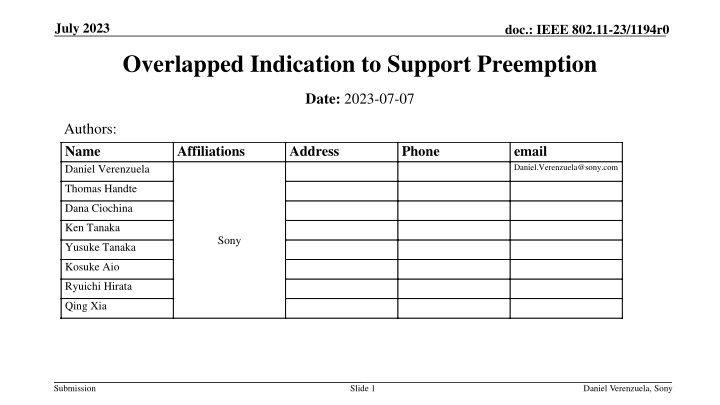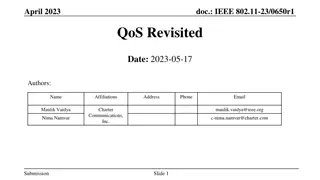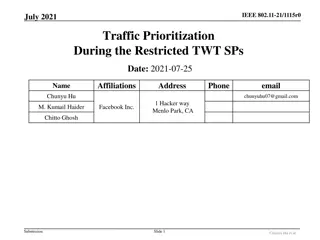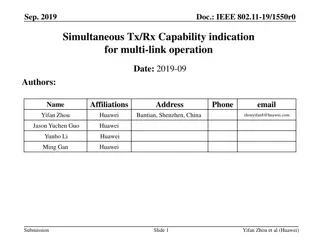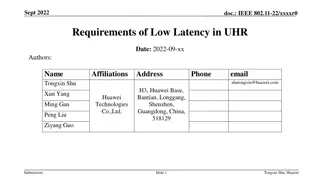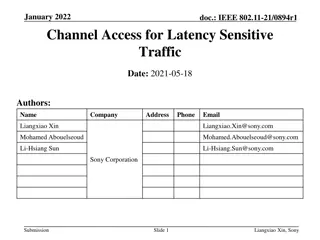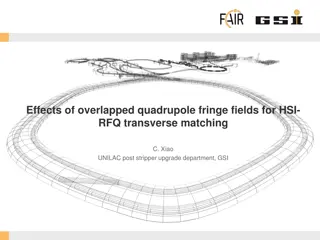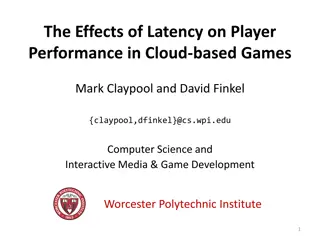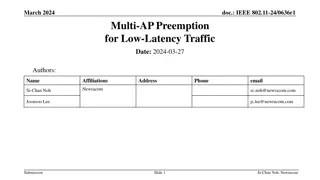Overlapped Indication for Event-Based Low Latency Traffic Support in IEEE 802.11
The document discusses the importance of reducing latency in Ultra High Rate (UHR) PAR and Event Based Low Latency (LL) traffic support in IEEE 802.11 networks. It introduces the concept of preemption to enhance LL traffic handling and proposes an overlapped LL indication frame to address challenges with event-based LL traffic awareness. The solutions aim to improve channel access efficiency and reduce latency tail distribution for better network performance.
Uploaded on Oct 08, 2024 | 3 Views
Download Presentation

Please find below an Image/Link to download the presentation.
The content on the website is provided AS IS for your information and personal use only. It may not be sold, licensed, or shared on other websites without obtaining consent from the author.If you encounter any issues during the download, it is possible that the publisher has removed the file from their server.
You are allowed to download the files provided on this website for personal or commercial use, subject to the condition that they are used lawfully. All files are the property of their respective owners.
The content on the website is provided AS IS for your information and personal use only. It may not be sold, licensed, or shared on other websites without obtaining consent from the author.
E N D
Presentation Transcript
July 2023 doc.: IEEE 802.11-23/1194r0 Overlapped Indication to Support Preemption Date: 2023-07-07 Authors: Name Daniel Verenzuela Affiliations Address Phone email Daniel.Verenzuela@sony.com Thomas Handte Dana Ciochina Ken Tanaka Sony Yusuke Tanaka Kosuke Aio Ryuichi Hirata Qing Xia Submission Slide 1 Daniel Verenzuela, Sony
July 2023 doc.: IEEE 802.11-23/1194r0 Introduction Reducing tail of latency distribution is a key component of UHR PAR [1] EHT features (e.g., R-TWT) focus on latency reduction of predictable Low-latency (LL) traffic Support of event-based LL traffic is missing [2] UHR contributions for low latency include Preemption [2-5] LL traffic classification and enhanced QoS signalling [7-9] Enhanced LL scheduling methods [10-12] Preemption is a good candidate to support event-based LL traffic [2-5] Basic concept is to suspend ongoing traffic to insert LL traffic Well suited when LL and non-LL traffic originate at TXOP holder (e.g., downlink) More challenging when STA with LL traffic is not the TXOP holder or responder (e.g., uplink) Submission Slide 2 Daniel Verenzuela, Sony
July 2023 doc.: IEEE 802.11-23/1194r0 Problem of event-based LL traffic awareness LL traffic originates at LL_STA that is not TXOP holder or responder LL_STA needs to wait until TXOP ends to start contention for channel access LL traffic arrival is unpredictable => AP cannot collect BSR in time The tail of latency distribution can be very long for large TXOPs and dense scenarios TXOP TXOP Holder (AP) TF BAck TF BAck TXOP responder TB-PPDU TB-PPDU LL_STA LL data Channel access latency LL arrival Submission Slide 3 Daniel Verenzuela, Sony
July 2023 doc.: IEEE 802.11-23/1194r0 Problem of event-based LL traffic awareness (existing solutions) [6] MLO can allow LL_STA to perform channel access in different links Depends on MLD capabilities (e.g., number of links, STR, NSTR, PS mode) LL_STA still needs to contend for channel access It is likely that the TXOP holder uses several links to increase throughput Reduce PPDU or TXOP size Short TXOP size reduces the time LL_STA needs to wait before contention [3] Short PPDUs with different IFS can allow LL_STA to contend before TXOP ends Drawbacks and limitations Small PPDU or TXOP size can reduce efficiency of channel usage Contention delay cannot be avoided Latency tail distribution can be very long if many STA contend at specific times Submission Slide 4 Daniel Verenzuela, Sony
July 2023 doc.: IEEE 802.11-23/1194r0 Proposal (1/3) Overlapped LL indication frame (LL_IF) Short frame containing robust sequence that identifies LL_STA LL_STA can send LL_IF overlapped with a TB-PPDU LL_IF indicates to the AP an arrival of urgent LL traffic at LL_STA TXOP TXOP Holder (AP) TF BAck TXOP responder TB-PPDU Fast LL traffic arrival awareness LL_STA LL_IF LL arrival Submission Slide 5 Daniel Verenzuela, Sony
July 2023 doc.: IEEE 802.11-23/1194r0 Proposal (2/3) Basic overlapped LL_IF operation AP can indicate, within trigger frame (TF), to LL_STA that a LL_IF may be sent in the TB PPDU If LL_STA has an event-based LL traffic arrival, it sends LL_IF overlapping with the data field of the ongoing TB PPDU AP detects LL_IF with simple detector (e.g., matched filter) Once a LL_IF is detected, AP can decide (e.g., preemption, TXOP sharing, different link, deny, ) Indication LL_IF allowed TXOP TXOP Holder (AP) TF BAck TF BAck Uplink preemption example TXOP responder TB-PPDU Fast LL traffic arrival awareness LL_STA LL_IF LL data Reduced channel access latency LL arrival Submission Slide 6 Daniel Verenzuela, Sony
July 2023 doc.: IEEE 802.11-23/1194r0 Proposal (3/3) Main benefits Event-based LL traffic awareness without contention delay Controlled channel access since AP can decide how to allocate resources LL_IF can be designed to cause negligible impact to ongoing PPDU reception Disadvantages Additional processing at the AP to detect LL_IF (small compared to PPDU demodulation) PPDU size may need to be limited to achieve very fast LL awareness Indication LL_IF allowed TXOP TXOP Holder (AP) TF BAck TF BAck Uplink preemption example TXOP responder TB-PPDU Fast LL traffic arrival awareness LL_STA LL_IF LL data Reduced channel access latency LL arrival Submission Slide 7 Daniel Verenzuela, Sony
July 2023 doc.: IEEE 802.11-23/1194r0 LL_IF design as OFDM waveform LL_IF should be a pre-agreed signal known to the AP that identifies LL_STA LL_IF can be defined as simple BPSK sequence (e.g., based on P matrix used for LTFs) LL_IF sequence can be mapped to a few active subcarriers (e.g., small RU) and OFDM symbols Ongoing PPDU Data field Data field Preamble Preamble data P4 = 26-tone RUs 26-tone RUs 106 Frequency (Subcarriers) Tone-RU Frequency (Subcarriers/Tones) pilot 106-tone RUs 106-tone RUs guard Reserved tones Reserved tones 26 Tone-RU pilot LL_IF example: P4 replicated 6 times 4 OFDM symbols 24 active subcarriers o Mapped into data subcarriers of 26-tone RU LL_IF 106 data Tone-RU Time (OFDM symbols) Time (OFDM symbols) Submission Slide 8 Daniel Verenzuela, Sony
July 2023 doc.: IEEE 802.11-23/1194r0 Synchronization aspects OFDM modulated LL_IF requires synchronization to ongoing PPDU transmission LL_STA can synchronize to the preamble of ongoing PPDU when in range of ongoing PPDU LL_STA can synchronize to PPDU (e.g., TF) immediately preceding ongoing PPDU TXOP holder (AP) TXOP Holder (AP) Extra processing to detect LL_IF Extra processing to detect LL_IF Prev. PPDU Ongoing PPDU Ongoing PPDU TXOP responder TXOP responder Preamble Data Preamble Data Wait time Switch RX-TX LL_STA Switch RX-TX LL_IF Sync. + decode Sync. + decode LL_STA LL_IF Available time to transmit LL_IF Available time to transmit LL_IF LL arrival LL arrival Submission Slide 9 Daniel Verenzuela, Sony
July 2023 doc.: IEEE 802.11-23/1194r0 Simulation results Ongoing PPDU 20 MHz Bandwidth, Channel type D MCS = 2, 4 GI = 0.8 us ~1dB loss at PER = 0.1 and MCS 4 ~0dB loss at PER = 0.1 and MCS 2 SIR = 20dB (rx_PPDU/rx_LL_IF) LL_IF impairments Residual CFO 200Hz Residual Time Offset ~Uniform(0,GI) LL_IF design and results 6x replication of P4 matrix 24 active subcarriers (26-tone RU) 4 OFDM symbols Detection Prob. > 0.7 for LL_IF SNR > 0dB MCS 4 MCS 2 Submission Slide 10 Daniel Verenzuela, Sony
July 2023 doc.: IEEE 802.11-23/1194r0 Additional considerations and specification relevance Signaling aspects There should be an agreement between STAs to control the usage of LL_IF Pre-agreement on sequences that will be sent as LL_IF to identify the LL_STA There can be explicit indications to allow or disallow the LL_IF overlap on specific PPDUs LL_IF transmission can be restricted to designated RUs LL_IF transmission power can be set to a specified limit or to achieve a SIR target Regulatory aspects LL_IF can be transmitted without CCA if the following considerations are met It does not contain data Less than 50 transmissions within 50ms period Combined duration of all LL_IF transmissions within 50ms should be less than 2.5ms Submission Slide 11 Daniel Verenzuela, Sony
July 2023 doc.: IEEE 802.11-23/1194r0 Summary and Conclusions Event-based LL traffic should be supported by UHR EHT only supports predictable LL traffic Preemption is a good candidate to support event-based LL traffic Event-based LL traffic suffers from arrival unawareness Solutions based on existing technologies may have long delays or low efficiency An overlapped LL indication frame can provide fast LL traffic awareness Avoid contention delay and maintain efficiency Negligible impact to reliability of ongoing PPDU Once AP is aware of LL traffic can provide controlled channel access Extension to EDCA channel access can be done Submission Slide 12 Daniel Verenzuela, Sony
July 2023 doc.: IEEE 802.11-23/1194r0 References [1] 11-23/0480r1 UHR proposed PAR [2] 11-23/1880r1 Latency and Reliability enhancements for UHR [3] 11-23/0092r0 Preemption for Low Latency Application [4] 11-23/0018r1 Low Latency Support in UHR [5] 11-22/1393r0 Latency Reduction Scheme for UHR [6] 11-19/1081r0 Multi-Link Aggregation: Latency Gains [7] 11-23/0069r1 Considerations on Latency Improvement (LG) [8] 11-23/0740r0 Dynamic QoS Feedback for UHR [9] 11-23/0885r0 Considerations on QoS Enhancement in UHR [10] 11-23/0771r0 Coordinated R-TWT Protection in Multi-BSS [11] 22/1899r0, Multi-AP Operation for Low Latency Traffic Delivery - Follow up [12] 22/1556r1, Multi-AP Coordination for Low Latency Traffic Delivery Submission Slide 13 Daniel Verenzuela, Sony
